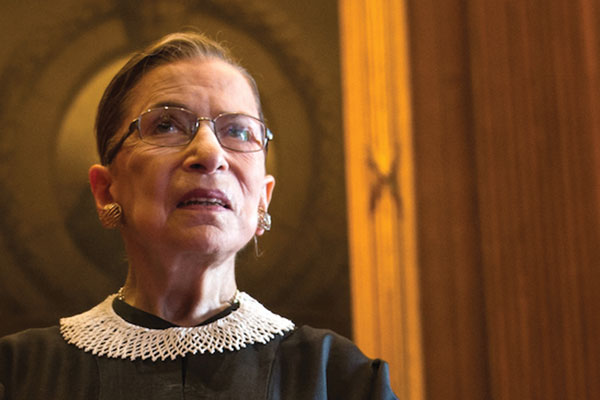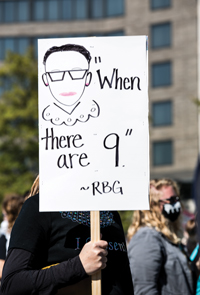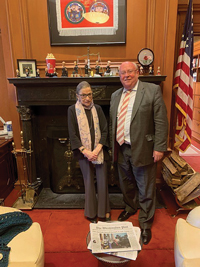*/

On 28 October last year I had the privilege of spending 45 minutes with Associate Justice Ruth Bader Ginsburg in her chambers at the Supreme Court in Washington DC. Much has been written about her being shy and reserved in company; that was not the person I met who was amusing, loquacious and anxious for news from England, particularly of the judgment recently given by the Supreme Court in the Miller case concerning the prorogation of Parliament.
Less than 12 months later she was lying in state in the same city having passed away on the 28 September thereby bringing to an end a truly great career as academic, practising lawyer and judge culminating in over 27 years as a Justice of the Supreme Court. She had become a cult figure revered by all who believed in gender equality and the liberal interpretation of the Constitution and Bill of Rights. She was, at the time of her death, the acknowledged leader of the liberal wing of the court.
Much has been written about her time in the Supreme Court and how her death may create a further shift in the political alignment of the court to the right; it is what she feared. She was critical of the current President and when I spoke to her she expressed the hope that she would live long enough to allow her replacement to be appointed by the next. In that hope she failed maybe by only a matter of months. She was on record as saying that ‘there will be a President after this one, and I’m hopeful that that President will be a fine President’. She expressed herself more bluntly when speaking to me.
When I met her she was in apparently good health despite several scares with cancer in the past and the debilitating effects of chemotherapy. The weekend before my visit she had flown to New York for the weekend to see an opera, one of her abiding loves, and seemed full of energy for someone of her age and said she was feeling well. I was shown her dissenting lace collar which she wore around her neck in court when giving a dissenting judgement; it was far more flamboyant than the one she wore when in the majority. She chose to wear the dissenting collar on the day after the election of the current President.
My visit was prompted by the decision of Gray’s Inn to make her an Honorary Bencher, something she graciously accepted, and my visit was to introduce myself as the current Treasurer of the Inn and give her a recently published book of our history. However, I think she was more touched by a modest gift from the female tenants of my chambers, who sent her a spider broach similar to the one worn by Lady Hale, another Bencher of Gray’s, when giving judgment in the prorogation case.
My return to London was swiftly followed by a letter from her to the female tenants of 2, Bedford Row warmly thanking them for the gift; the significance of which I did not need to explain to her.
A visit to her chambers in Washington was something of a revelation; each justice had a large suite of rooms with secretarial staff, legal assistants and all the help that they might need. It made me reflect on the rather more modest support given to our judges. Her private chambers were extremely comfortable with some good art on the wall and a real fire for use in the winter. There were plenty of papers for pending cases as most of the advocacy is written, with normally oral submissions being strictly limited to 30 minutes. The court usually sits Monday to Wednesday and hears two appeals each morning.
She explained that for the first two minutes of oral argument the Justices were not allowed to interrupt and ask a question; she said they were often the longest two minutes you could imagine! She thought our system of much longer oral submissions had little to commend it.
One could not help but reflect on the fact that appointments to the Supreme Court are for life with no forced retirement through age. Ruth Ginsburg was 87 years of age when she died. She was one of four Justices aged over 70. Had she been appointed a judge today in the Supreme Court in this country, she and the other three would have been required to step down aged 70. In her case, 17 years of her judicial career would have been lost. One is driven to reflect how much judicial talent can be wasted here by the mandatary early retirement age for all judges.
Nominated by Bill Clinton in 1993, she was confirmed by the Senate by 93 votes to 3, an endorsement it is difficult to imagine in today’s more politically polarised Senate. In her early years on the Supreme Court Bench she gave the leading judgment in some landmark cases on gender equality including the 1996 landmark case involving the Virginia Military Institute in Lexington which, until then, had been an exclusively male preserve. Giving judgment for the majority, Justice Ginsburg memorably stated that ‘inherent differences between men and women, we have come to appreciate, remain cause for celebration’ adding that the Constitution was not compatible with the ‘denigration of the members of either sex or for artificial constraints on an individual’s opportunity’. In 2018 she was invited to address the cadets at the institute, where some 200 women had graduated, and remarked that she knew that women would make the institute a better place.
It is well recorded that over the 27 years she served in the Supreme Court the constitution of the court moved politically to the right as successive Republican Presidents appointed fresh justices and replaced those that shared her liberal inclinations This resulted in her more frequently becoming the dissenting voice of the liberal wing of the court and in time her dissenting judgments, frequently given from the Bench, were often better received than those of the majority. This was never more so than in the case of Ledbetter v Goodyear where she gave the dissenting judgment in a 5 to 4 decision of the court where a woman’s pay discrimination case failed because the court held that the time limit for bringing the claim ran from when the discrimination began and not from when the women first learnt of it. Justice Ginsburg memorably ended her powerful dissent by saying that ‘the ball is now in Congress’s court’. Congress promptly rose to the challenge and the first bill President Obama signed was the Lilly Ledbetter Fair Pay Act overruling the decision of the Supreme Court which Justice Ginsburg had described as a ‘parsimonious reading of the Civil Rights Act’.
It was cases such as the Ledbetter case that cemented her reputation as a liberal and fair-minded judge and contributed to her becoming a cult figure for liberal thinkers. Bumper stickers proclaiming ‘There can be no Truth without Ruth’ became a familiar sight on the roads and her reputation ensured that she was in constant demand to speak at colleges and universities throughout the country.
That she was a great person in every sense cannot be denied. As an appeal advocate, she won six of her seven cases in the Supreme Court fighting for gender equality and women’s rights. As a judge she continued that fight and will be remembered as one of the great lawyers of her generation. Let us hope that her legacy is not diminished by her failure to outlive the term of the President Trump.
*
So what is it that the Bar can learn from Ruth Ginsburg? No one worked harder than she did on her cases whether as an advocate or as a judge. She would frequently work into the early hours right up to the end of her life, yet she found time for other interests outside the law. She was lucky to have a devoted husband and family who supported her throughout her career. Her love of opera is well documented. All lawyers, and for that matter all professionals, work better with a settled home life and all benefit from having outside interests.
In that respect, Ruth Ginsburg was no different from many others, but what set her apart was her fierce intelligence and her determination to right what she recognised as injustices. She did that by working within the system not by trying to destroy it. She saw her role as someone who had to educate the judges she appeared before rather than attack them and by doing so was successful time and again when others may have failed. She was not an aggressive advocate but a determined one who succeeded by quiet persuasion rather than flamboyant oratory. On the Bench she remained true to her liberal beliefs and did much to continue the fight for gender equality.
But when it comes to what we can learn from her, at the end of the day, it is the ability to recognise a great person for who and what they are. We cannot emulate her career; no one can, her style was hers. It would be a mistake to try and copy it. All we can do is remember that hard work and mastery of your brief is as important now as it was forty years ago when Ruth Ginsburg was appearing in the Supreme Court.




On 28 October last year I had the privilege of spending 45 minutes with Associate Justice Ruth Bader Ginsburg in her chambers at the Supreme Court in Washington DC. Much has been written about her being shy and reserved in company; that was not the person I met who was amusing, loquacious and anxious for news from England, particularly of the judgment recently given by the Supreme Court in the Miller case concerning the prorogation of Parliament.
Less than 12 months later she was lying in state in the same city having passed away on the 28 September thereby bringing to an end a truly great career as academic, practising lawyer and judge culminating in over 27 years as a Justice of the Supreme Court. She had become a cult figure revered by all who believed in gender equality and the liberal interpretation of the Constitution and Bill of Rights. She was, at the time of her death, the acknowledged leader of the liberal wing of the court.
Much has been written about her time in the Supreme Court and how her death may create a further shift in the political alignment of the court to the right; it is what she feared. She was critical of the current President and when I spoke to her she expressed the hope that she would live long enough to allow her replacement to be appointed by the next. In that hope she failed maybe by only a matter of months. She was on record as saying that ‘there will be a President after this one, and I’m hopeful that that President will be a fine President’. She expressed herself more bluntly when speaking to me.
When I met her she was in apparently good health despite several scares with cancer in the past and the debilitating effects of chemotherapy. The weekend before my visit she had flown to New York for the weekend to see an opera, one of her abiding loves, and seemed full of energy for someone of her age and said she was feeling well. I was shown her dissenting lace collar which she wore around her neck in court when giving a dissenting judgement; it was far more flamboyant than the one she wore when in the majority. She chose to wear the dissenting collar on the day after the election of the current President.
My visit was prompted by the decision of Gray’s Inn to make her an Honorary Bencher, something she graciously accepted, and my visit was to introduce myself as the current Treasurer of the Inn and give her a recently published book of our history. However, I think she was more touched by a modest gift from the female tenants of my chambers, who sent her a spider broach similar to the one worn by Lady Hale, another Bencher of Gray’s, when giving judgment in the prorogation case.
My return to London was swiftly followed by a letter from her to the female tenants of 2, Bedford Row warmly thanking them for the gift; the significance of which I did not need to explain to her.
A visit to her chambers in Washington was something of a revelation; each justice had a large suite of rooms with secretarial staff, legal assistants and all the help that they might need. It made me reflect on the rather more modest support given to our judges. Her private chambers were extremely comfortable with some good art on the wall and a real fire for use in the winter. There were plenty of papers for pending cases as most of the advocacy is written, with normally oral submissions being strictly limited to 30 minutes. The court usually sits Monday to Wednesday and hears two appeals each morning.
She explained that for the first two minutes of oral argument the Justices were not allowed to interrupt and ask a question; she said they were often the longest two minutes you could imagine! She thought our system of much longer oral submissions had little to commend it.
One could not help but reflect on the fact that appointments to the Supreme Court are for life with no forced retirement through age. Ruth Ginsburg was 87 years of age when she died. She was one of four Justices aged over 70. Had she been appointed a judge today in the Supreme Court in this country, she and the other three would have been required to step down aged 70. In her case, 17 years of her judicial career would have been lost. One is driven to reflect how much judicial talent can be wasted here by the mandatary early retirement age for all judges.
Nominated by Bill Clinton in 1993, she was confirmed by the Senate by 93 votes to 3, an endorsement it is difficult to imagine in today’s more politically polarised Senate. In her early years on the Supreme Court Bench she gave the leading judgment in some landmark cases on gender equality including the 1996 landmark case involving the Virginia Military Institute in Lexington which, until then, had been an exclusively male preserve. Giving judgment for the majority, Justice Ginsburg memorably stated that ‘inherent differences between men and women, we have come to appreciate, remain cause for celebration’ adding that the Constitution was not compatible with the ‘denigration of the members of either sex or for artificial constraints on an individual’s opportunity’. In 2018 she was invited to address the cadets at the institute, where some 200 women had graduated, and remarked that she knew that women would make the institute a better place.
It is well recorded that over the 27 years she served in the Supreme Court the constitution of the court moved politically to the right as successive Republican Presidents appointed fresh justices and replaced those that shared her liberal inclinations This resulted in her more frequently becoming the dissenting voice of the liberal wing of the court and in time her dissenting judgments, frequently given from the Bench, were often better received than those of the majority. This was never more so than in the case of Ledbetter v Goodyear where she gave the dissenting judgment in a 5 to 4 decision of the court where a woman’s pay discrimination case failed because the court held that the time limit for bringing the claim ran from when the discrimination began and not from when the women first learnt of it. Justice Ginsburg memorably ended her powerful dissent by saying that ‘the ball is now in Congress’s court’. Congress promptly rose to the challenge and the first bill President Obama signed was the Lilly Ledbetter Fair Pay Act overruling the decision of the Supreme Court which Justice Ginsburg had described as a ‘parsimonious reading of the Civil Rights Act’.
It was cases such as the Ledbetter case that cemented her reputation as a liberal and fair-minded judge and contributed to her becoming a cult figure for liberal thinkers. Bumper stickers proclaiming ‘There can be no Truth without Ruth’ became a familiar sight on the roads and her reputation ensured that she was in constant demand to speak at colleges and universities throughout the country.
That she was a great person in every sense cannot be denied. As an appeal advocate, she won six of her seven cases in the Supreme Court fighting for gender equality and women’s rights. As a judge she continued that fight and will be remembered as one of the great lawyers of her generation. Let us hope that her legacy is not diminished by her failure to outlive the term of the President Trump.
*
So what is it that the Bar can learn from Ruth Ginsburg? No one worked harder than she did on her cases whether as an advocate or as a judge. She would frequently work into the early hours right up to the end of her life, yet she found time for other interests outside the law. She was lucky to have a devoted husband and family who supported her throughout her career. Her love of opera is well documented. All lawyers, and for that matter all professionals, work better with a settled home life and all benefit from having outside interests.
In that respect, Ruth Ginsburg was no different from many others, but what set her apart was her fierce intelligence and her determination to right what she recognised as injustices. She did that by working within the system not by trying to destroy it. She saw her role as someone who had to educate the judges she appeared before rather than attack them and by doing so was successful time and again when others may have failed. She was not an aggressive advocate but a determined one who succeeded by quiet persuasion rather than flamboyant oratory. On the Bench she remained true to her liberal beliefs and did much to continue the fight for gender equality.
But when it comes to what we can learn from her, at the end of the day, it is the ability to recognise a great person for who and what they are. We cannot emulate her career; no one can, her style was hers. It would be a mistake to try and copy it. All we can do is remember that hard work and mastery of your brief is as important now as it was forty years ago when Ruth Ginsburg was appearing in the Supreme Court.





Chair of the Bar reflects on 2025
AlphaBiolabs has donated £500 to The Christie Charity through its Giving Back initiative, helping to support cancer care, treatment and research across Greater Manchester, Cheshire and further afield
Q&A with criminal barrister Nick Murphy, who moved to New Park Court Chambers on the North Eastern Circuit in search of a better work-life balance
Revolt Cycling in Holborn, London’s first sustainable fitness studio, invites barristers to join the revolution – turning pedal power into clean energy
Rachel Davenport, Co-founder and Director at AlphaBiolabs, reflects on how the company’s Giving Back ethos continues to make a difference to communities across the UK
By Marie Law, Director of Toxicology at AlphaBiolabs
Are you ready for the new way to do tax returns? David Southern KC explains the biggest change since HMRC launched self-assessment more than 30 years ago... and its impact on the Bar
Professor Dominic Regan and Seán Jones KC present their best buys for this holiday season
Marking one year since a Bar disciplinary tribunal dismissed all charges against her, Dr Charlotte Proudman discusses the experience, her formative years and next steps. Interview by Anthony Inglese CB
Little has changed since Burns v Burns . Cohabiting couples deserve better than to be left on the blasted heath with the existing witch’s brew for another four decades, argues Christopher Stirling
Pointillism, radical politics and social conscience. Review by Stephen Cragg KC